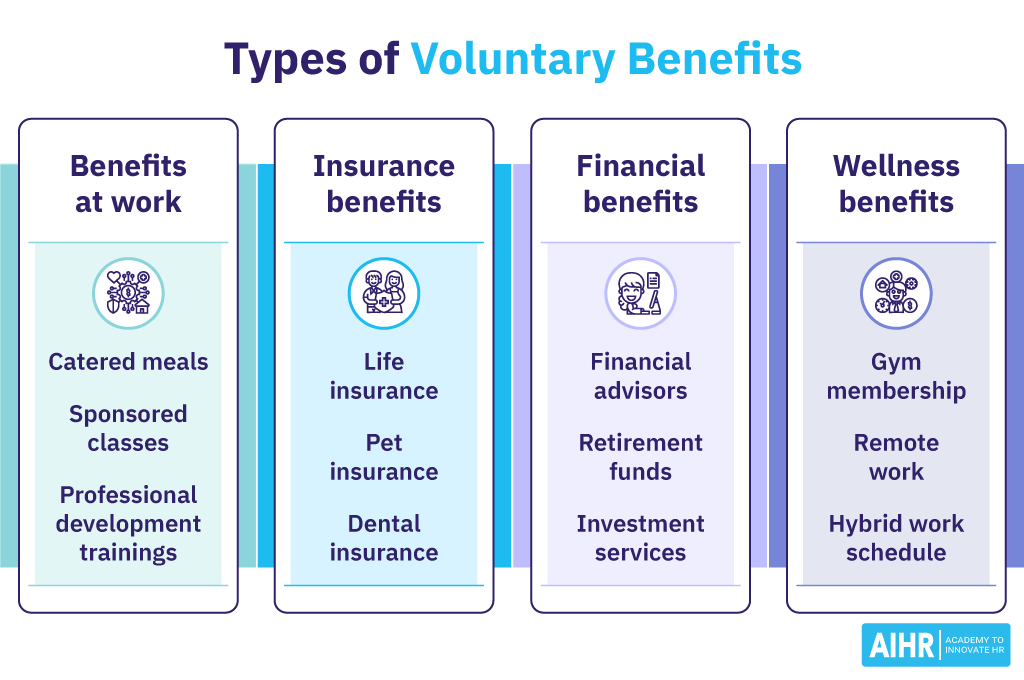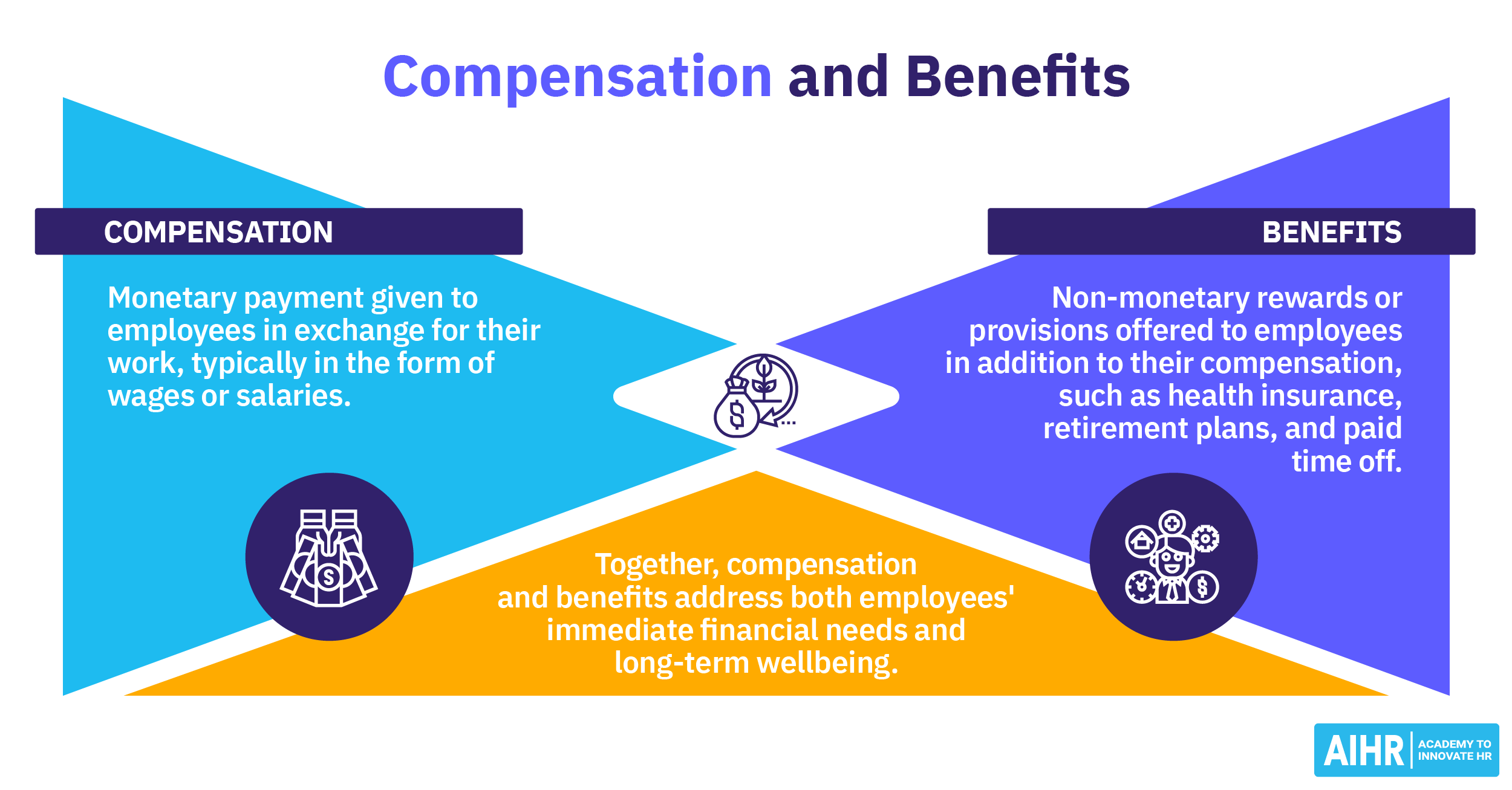Voluntary Benefits
What are voluntary benefits?
Voluntary benefits are benefits employees opt into and may pay a portion of the cost for. They are best understood in contrast to employment benefits. An employment benefit is part of an employee’s contractual compensation, so it is automatically provided, and the cost is part of an employee’s pay.
Employee voluntary benefits, on the other hand, are benefits the employer makes available for employees to voluntarily participate in. The cost of voluntary benefits can be complimentary or discounted, paid by the employee, or deducted from their paycheck after they opt-in. Many are pitched as workplace perks within a voluntary benefits plan that employees may choose to access.
Voluntary benefits examples
There are several different types of voluntary benefits each employer should consider when putting together their compensation package. These are some of the most common examples of voluntary benefits:
1. Voluntary benefits at work
Workplace voluntary benefits can include catered meals, an office gym, sponsored classes, or professional development training. These benefits are available to the employee during their working hours or when they are on the office premises.
2. Insurance
Insurance is often offered as a voluntary employee benefit. While health insurance might be a standard benefit, employees can personalize their coverage through options like life insurance, pet insurance, critical illness insurance, and other specialized plans, often at more affordable rates through the employer’s voluntary benefits program.
3. Healthcare
Voluntary health benefits allow employees to tailor their health coverage to their needs. For instance, vision insurance being a voluntary option, can help save costs for those who don’t need it while offering coverage for those who do. Other examples include dental insurance or access to physical therapy services.

4. Financial benefits
Financial wellness has become a new focus in workplace benefits, and the best way to offer this is through employee voluntary benefits. Examples of financial voluntary benefits include financial advisors, savings programs, managed retirement funds, and access to managed investment services.
5. Wellness
Wellness-related voluntary benefits are often offered as voluntary benefits to allow employees to choose their wellness path. These benefits include gym memberships, meal plans, remote work, hybrid work schedules, and other unique programs the employer may choose to offer.
6. Other voluntary benefits
In addition to the types of benefits listed above, employees might also be able to join company sports teams, sign up for events and trips, receive frequent flyer miles for their travels, or participate in contests or other unique, beneficial programs their employer might offer.
Voluntary benefits quick numbers
According to a Goldman Sachs report,
- 95% of companies offer mental health support as a voluntary benefit
- 68% offer critical illness insurance
- 58% provide pet insurance
- 56% offer hospital indemnity insurance
- 55% offer child and elder care assistance
- 31% offer student loan repayment programs.
Why are voluntary benefits important?
Voluntary benefits are important because they offer flexibility and choice, allowing employees to tailor their compensation package to meet personal needs. This can boost job satisfaction and engagement, as employees feel their circumstances are considered. For employers, a strong voluntary benefits plan is cost-effective, enhancing the overall package without bearing the full financial burden.
Additionally, they help attract and retain top talent by making the organization more competitive in the job market. They also support employee wellbeing, covering areas like financial security, health, and work-life balance, which can lead to higher productivity and reduced absenteeism.
Advantages and disadvantages of offering voluntary benefits
Advantages
- Attracts and retains employees: A diverse range of voluntary benefits makes an organization more appealing to potential hires and helps retain current employees.
- Customizable and flexible: Employees can choose benefits that fit their personal needs, such as supplemental health insurance, pet insurance, or financial wellness programs.
- Promotes financial and personal wellbeing: Voluntary benefits often cover gaps in traditional plans, providing added security and peace of mind.
- Enhances employer brand: A comprehensive benefits package signals that the company values employee wellbeing, which strengthens its reputation as an employer of choice.
Disadvantages
- Administrative complexity: Managing a wide range of these benefits can be time-consuming, especially when dealing with multiple vendors.
- Potential for inequity: Some voluntary benefits may appeal more to specific groups within the workforce, leading others to feel left out if their needs aren’t addressed.
- Risk of low ROI: If employee participation is low, the resources spent on implementing and managing the programs might not deliver the expected return on investment.
- Possible compliance issues: Some voluntary benefits, like certain insurance products, may come with regulatory or tax implications that require careful handling to avoid compliance risks.
Learn to design voluntary benefits plans
Build the skills to create voluntary benefits programs that enhance employee satisfaction and retention while managing costs and ensuring compliance.
AIHR’s Compensation & Benefits Certificate Program will teach you to design and manage comprehensive benefits plans, including voluntary benefits.
How can HR determine which voluntary benefits to offer?
Many of the most successful brands put together a suite of voluntary benefits that fall into several categories. These categories generally include Health, Financial, Career, and Lifestyle/Wellness. Offering a well-rounded selection ensures support for employees with diverse lifestyles and priorities.
The best way to decide which options to include is to carefully consider employees’ needs and interests. Consider these strategies to direct your decision:
- Conduct employee surveys to gauge preferences and needs
- Analyze demographics
- Benchmark competitors
- Assess the financial feasibility of offering specific benefits
- Keep track of benefit utilization and adjust offerings based on feedback and trends.
Through these metrics, you can discover which benefits are most desired, most used, and most likely to be appreciated in the future by your organization’s staff.
HR tip
When designing a voluntary benefits plan, look for benefits that appeal to the largest number of people in your organization. Keep in mind inclusivity regarding physical access, food allergies, and schedule restrictions to maximize participation.
FAQ
Voluntary benefits are optional, employee-paid benefits offered through the workplace to enhance traditional benefits packages. They include options like dental, vision, life insurance, pet insurance, and mental health support. Employees choose and pay for the benefits that best fit their needs, often at group rates that cost less than individual plans.
Voluntary benefits can be pre-tax, depending on the type of benefit and how it’s structured. Benefits like health insurance premiums often qualify for pre-tax deductions, while others, such as disability or life insurance, are typically post-tax. Check with your employer or benefits provider for specific details.
Mandatory benefits are those employers are legally required to provide, such as Social Security, workers’ compensation, and unemployment insurance. Voluntary benefits, on the other hand, are optional offerings like life insurance, pet insurance, or wellness programs that employees can choose to enroll in, often at their own expense.









